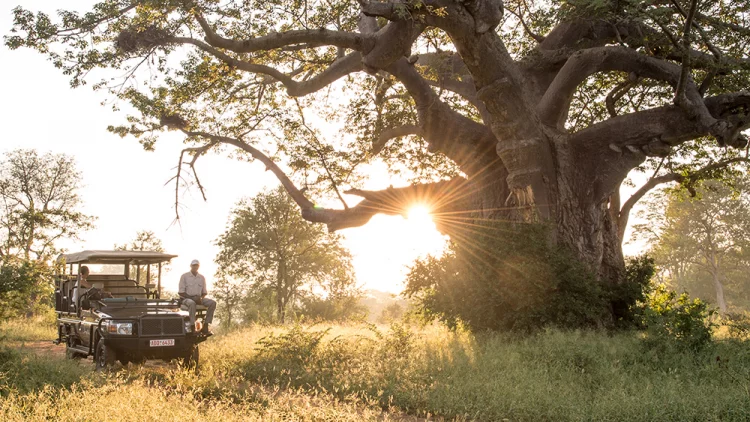Why the Best African Safaris Aren’t Always the Most Luxurious
Mixing and matching outdoor adventure with soulful lodges can create a luxury experience that's better than any five-star hotel stay, experts say.

In the southeastern corner of Zimbabwe, 50 miles from the border of Mozambique, the scars of cattle ranching and mid-century clear-cutting, a failed war against the tsetse fly, are still legible in the bush. Decades of hard, often Sisyphean conservation work have succeeded in showing the resilience of the savanna’s low acacia and fever trees, thorny shrubs, and monumental ancient baobabs. Today, this wild place has a happier problem: an abundance of rhinoceros. Within the 130,000-acre Malilangwe Wildlife Reserve, they are a daily, no-binoculars-needed sight. The lodge here is Singita Pamushana, one of the most superlative in Africa, set high in the jagged exposed rocks above the Malilangwe Dam and its rainwater lake, where hippos bellow and elephants bathe. Comprising only eight house-sized suites with working wood fireplaces and private pools, it’s also an exclusive booking that draws in-the-know families back year after year.

Many travel from Europe or the US simply to stay here and enjoy the better-than-you’d-expect wine cellar, central pool, and water views from a mountain lodge surrounded by some of the world’s best-managed safari animals. Others come here as a part of a wider trip through Zimbabwe—after a jaunt to Victoria Falls, say.
But, Elizabeth Gordon, CEO of Extraordinary Journeys, a private excursion operator, recommends something a little more gourmet: pairing the yin of Pamushana with the yang of Loapi, a new ultra-luxury safari camp in the Kalahari’s Tswalu game reserve (and one of Robb Report’s 50 best hotels in the world).
Opened in July, Laopi’s six tented safari homes—each with personal butlers, private chefs,r and private plunge pools—are set within 281,700 acres of otherworldly desert landscape in South Africa’s largest private game reserve.
Not only does the land here give an antithesis to the water and foliage of Pamushana, but so does the game. The big five—even elusive leopards—can be found in Malilangwe. But the desert is for creatures more elusive still: wild dogs, cheetahs, aardvarks, brown hyenas, porcupine, and pangolins. There are desert rhinos here, as well as massive dark-maned lions, leopards, buffalo, and many other familiar safari species—but no elephants. Meerkats are the stars, here. The contradiction is the point.

“Don’t be afraid to mix and match,” says Gordon, who was born in Kenya. “I’m always looking for places that are unique, more interesting, that aren’t a typical hotel. They have to have heart and soul.”
Gordon is an expert at creating zebra-stripe safaris: high-contrast adventures with dueling landscapes and experiences. But more than merely emphasizing difference, her philosophy of safari is one all world wanderers can take to heart: “Luxury” alone is too easy, and therefore, less luxurious. You need to “earn it” through discovery.
“You have to try something new because that’s what Africa is all about,” she says. “To see the ruins of Great Zimbabwe you have to stay at a really simple hotel. Canoeing the Zambezi is not comfortable, but it’s exciting. Walking for three days through Lewa with tents and bucket showers is nothing fancy but it is very experiential. Sure, going to a Four Seasons is luxury, but it’s easy.”
That doesn’t mean white-glove service in a five-star hotel isn’t your reward—but to create an extraordinary journey, Gordon recommends skipping the Marriott and booking hotels that offer something authentic. There’s the resort-style Fairlawns in Johannesburg where every room is unique, or Cape Town’s residential urban boutique Cape Cadogan and the art-filled Ellerman House. A four-night sojourn at the jewel-box-sized Clarendon in Bantry Bay is better appreciated between exhilarating game drives in Makanyi Private Game Lodge in Greater Kruger National Park and andBeyond Sossusvlei Desert Lodge in Namibia.

Getting to and between the richest private camps and imaginative hotels in Africa offers its own opportunity to turn the worst part of travel into its own highlight.
I traveled from Sydney directly to Johannesburg, thanks to the newly doubled Qantas capacity on the A380 superjumbo on that route since October. It’s the first airline to fly that plane between the two commonwealth countries and it’s already adding 54,000 seats.
The Australian carrier also recently made that long-haul flight a lot more enjoyable, pouring $100 million into upgrading its network of lounges and adding restaurant-style dining from a menu designed by Australian Chef Neil Perry to its 14 onboard first-class suites.
(Speaking of “long-haul,” in 2025 the airline is going to push it to the limit with “Project Sunrise:” an ultra-long-haul direct from Sydney to N.Y.C. designed by a multidisciplinary team of sleep scientists.)

Once you’re in Africa and off the jumbo jet, small private charters land on dusty runways directly in or just outside the camp—provided that no zebras are on the runway. Back in Joberg and Cape Town black cars are waiting on the runway to whisk you to urban resorts. Flying so rarely feels joyful but juxtaposition between aviation styles is one way to inject it with comfort and interest.
“When you come from the lush bush and mountains of Zimbabwe to the Kalahari you see less, but what you see is more purposeful,” says Gordon. “It makes seeing that cheetah on the top of a dune all the more impressive. Cool adventures are still out there.“

 oujisama
oujisama 












